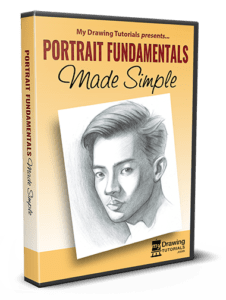
If you wanna learn more about portrait drawing, check out my “Portrait Fundamentals Made Simple” course.
It’s a very beginner-friendly course that walks you through all the basics of portraiture, from constructing a basic head, facial proportions, drawing the features, and finally drawing a realistic portrait step-by-step.
Lesson Transcript
Now that we’re familiar with the rules of proportions for the head, let’s see how we can use that information to draw a 3D head. Drawing these mannequinized heads will help you to better understand the placements and basic construction of the features and also how the head will be affected by perspective when viewed from different angles. So let’s get started!
The first step is to draw a simplified head from the front view using the steps we covered in the previous lessons…
OK, so here’s our starting point. Now, extend the jaw lines upward until they meet the top portion of the head. Then erase the extra side portion. This will bring the drawing even close to the shape of a real head.
Now, let’s find the placements of the features.
We know that they eyes will be 1 eye-width apart, with 1 eye-width of space on each sides. In this drawing, the space on each sides of the eyes has already been marked out for us, so I’ll just divide the brow line into 3 sections.
And this section in the middle will represent the space between the eyes. And these two sections here will represent the eyes themselves.
If everything works out perfectly, all 5 sections should be the same size. But if they are a little off, that’s completely fine. Remember, the rules of proportions are meant to be used as a guide, not as an exact measurement.
OK, we’ll leave it at that for now and begin drawing the nose.
There is a keystone shape called the glabella that sits between the eyebrows and at the top of the nose. Let’s draw in this in. This shape is slightly narrower than the space between the eyes.
Then we’ll go to the nose line and draw another keystone shape to represent the bottom of the nose. This shape will be slightly narrower than the first.
Now connect the two shapes via straight lines. This will represent the bridge of the nose.
To finish out the nose, we’ll draw two small triangles on the side. These will represent the nostrils. And then connect them with the top of the nose bridge.
By the way, as you might recall, the width of the nose is equal to the space between the eyes. So as you are drawing the nose, be sure to calibrate the size so that it will fit within that gap.
Now we can turn our attention to the eyes. For simplicity, we will be drawing eyes and eyebrows as a single unit. So, I’ll reinforce the browline and close out the bottom portion of the eye area.
Next, we’ll fill in the forehead. Draw another large keystone shape that extend from the brow line to the hair line. This will represent the front plane of the forehead. Then connect this keystone shape with the side of the head using slightly sloping lines. Then connect that point to the edge of the face using steeper lines. You’ll want this line to connect with the edge of the face at slightly below the eyes.
Now we’ll just erase these lines here and change them into straight lines. And we’ll do the same for these curves. Erase the curve… and change it to a straight line. I’ll end the line right about there… and connect it to the edge of the face. Do the same for the other side.
OK, now for the lower portion of the face.
The lips will be about 1/3 of the way down from the nose. So, if we divide the space between the bottom of the nose and the chin into thirds, the center of the lips will be right here.
From here, we’ll draw a small V shape and close it out with a smaller V shape. We should end up with a sort of triangle shape like this. This will represent the center of the upper lip.
And we’ll just connect it to the nose like so. This area will represent the philtrum. The philtrum is the grove that sits between the base of the nose and the top of the lips.
To finish out the upper lip, we just have to figure out how wide it’s going to be. The width of the lips will roughly correspond to the center of the eyes. So, if we estimate the the center of the eyes would be at these points. Then the corners of the lips will be about here.
If you think this would make the lips too wide, you can bring the points in a little closer.
Extend the upper lips to these corners. And then finish out the lower portion. The line will curve up in the middle before sloping down to meet the corners.
To draw the lower lips, we’ll first drawing a short horizontal line and then angle it upward until it connects with the corners.
Then we’ll divide up the planes of the lower lip by drawing in these lines.
Now connect the corners of the lips to the corners of the nose. Then connect the corners of the lips to these points here. Then connect these points to the corners of the jaw. These new lines we just made represent yet more plane changes on the face.
Next, we have the chin. Draw two small keystone shapes underneath the lips like so. These will represent the divot that lays between the lower lip and chin.
Now just connect the corners of this shape with the corners of the chin and we got ourselves a three dimensional chin!
Lastly, we’ll draw in the ears. The ears will fit between the brow line and the bottom of the nose. We’ll depict the ears with simple shapes formed with straight lines. And that’s it, we’re all done!


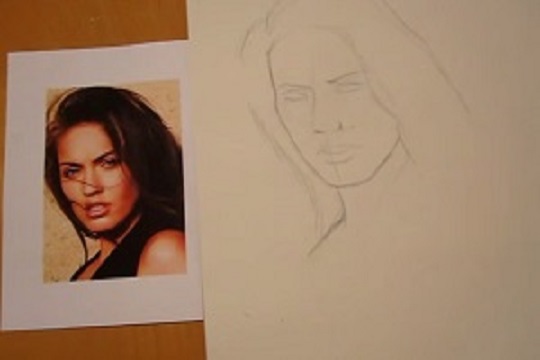
![Drawing Realistic Portrait Series [1 of 8] – Intro & Materials](https://mydrawingtutorials.com/wp-content/uploads/2012/08/Portrait-Lesson-1.jpg)
![Drawing Realistic Portrait Series [2 of 8] – The Fundamentals of Shading](https://mydrawingtutorials.com/wp-content/uploads/2012/08/Portrait-Lesson-2.jpg)

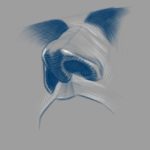
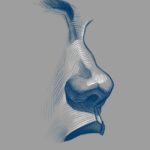
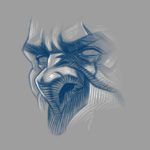
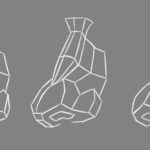

Thank you, but I am starting to lose my vision and had great difficultybtrying to read what you have wtitten – and drawn of course!
Thanks again – Brian Larkins